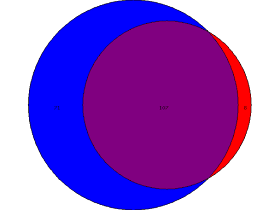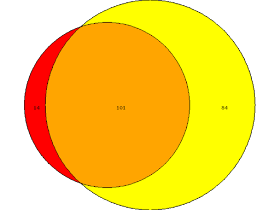I have enjoyed the feedback, especially on twitter, from lots of people since I dusted down the blogging machine and reignited it earlier this week. I should blog more often! I had forgotten how much fun it is.
Anyway, this is the third post in the current series; cf. post one and post two.
Before continuing with critical reflections on Matthew Larsen's Gospels Before the Book, I'd like to pause to think a bit more about how we represent degrees of similarity between the Synoptic Gospels. This has been one of the most enjoyable take-aways from reflecting over the last couple of days. Larsen produced a proportional Venn diagram (p. 104) of the degree of similarity between Matthew and Mark in a bid to show just how similar these works are. He uses the pericope divisions in Aland's Synopsis. Here's my coloured version of his diagram, using my Synoptic colouring scheme: [2]:
Anyway, this is the third post in the current series; cf. post one and post two.
Before continuing with critical reflections on Matthew Larsen's Gospels Before the Book, I'd like to pause to think a bit more about how we represent degrees of similarity between the Synoptic Gospels. This has been one of the most enjoyable take-aways from reflecting over the last couple of days. Larsen produced a proportional Venn diagram (p. 104) of the degree of similarity between Matthew and Mark in a bid to show just how similar these works are. He uses the pericope divisions in Aland's Synopsis. Here's my coloured version of his diagram, using my Synoptic colouring scheme: [2]:
Key:
Matthew's non-Marcan material (blue)
Mark's non-Matthean material (red)
Material shared by Matthew and Mark (purple)
The numbers:
Mark: 115 Aland pericopae
Matthew: 178 Aland pericopae
Overlapping: 107 Aland pericopae
93% of Mark is paralleled in Matthew.
60% of Matthew is paralleled in Mark.
The diagram, though rough and ready, provides one metric for seeing how closely related Matthew is to Mark. The question then arises: what about Luke's relation to Mark? How close is it? Here's the proportional Venn diagram, again using my colouring scheme:
Key:
Mark's non-Lucan material (red)
Material shared by Mark and Luke (orange)
The numbers:
Mark: 115 Aland pericopae
Luke: 185 Aland pericopae
Overlapping: 101 Aland pericopae
88% of Mark is paralleled in Luke.
55% of Luke is paralleled in Mark.
These figures are surprisingly similar to the figures for Matthew, surprising as Matthew is often regarded as so much closer to Mark, a kind of "second edition" of Mark. To some extent, this is a result of using the Aland pericopae rather than the traditional verse parallels, but I look forward to running some more precise numbers in due course.
The thing that got me thinking afresh about this whole question was Larsen's comment that "there are no two works from the ancient world more similar to each other" than Matthew and Mark. As I mentioned the other day, I am not sure if this is right. Matthew and Luke are much more similar overall, but we tend to miss this because of classic Two-Source Theory thinking that minimizes their macro-similarities, and projects their close non-Marcan agreements onto a non-extant source, with a view to maintaining their independence from one another. Here's the proportional Venn diagram, again using my colouring scheme, and again using the Aland pericopae:
Matthew's non-Lucan material (blue)
Luke's non-Matthean material (yellow)
Material shared by Matthew and Luke (green)
The numbers:
Matthew: 178 Aland pericopae
Luke: 185 Aland pericopae
Overlapping: 137 Aland pericopae
74% of Matthew is paralleled in Luke.
77% of Luke is paralleled in Matthew.
I am grateful to Joe Weaks on The Macintosh Biblioblog (this is all wonderfully nostalgic!) for raising the question about the utility of traditional Venn diagrams like this. His suggestion is to work instead with rectangles:
Graphically Displaying Synoptic Data
This post shows how we can attempt to represent Matthew // Mark, Mark // Luke, and Matthew // Luke using coloured rectangles. I must admit that I really like Weaks's proposal, and not just because we use the same colour scheme. The only thing I'd say is that I think it would be harder to do the rectangle thing in black and white because it would be less clear that we are dealing with overlapping rectangles, whereas with circles, it is obvious even in black and white where one work ends and another begins.
Weaks continues by asking the next major question: can one represent the overlaps between all three Synoptics using the coloured rectangle approach? Weaks shows that it is possible here:
Graphically Displaying Three Synoptic Gospel Data
This diagram is also excellent. My only qualm is that on first sight, it can look like the double tradition (green) is also part of the triple tradition (brown), which is of course not the case, and one simply has to discipline one's mind not to see it that way, though of course in a more complex version one could at least attempt to depict with shades of colour pericopae that are pure triple (with only a handful of minor agreements), pure double (with no Marcan agreements), and everything in between. But life is probably too short for that.



Thanks for these posts, Mark. I've been working on some related modeling and have written up a short discussion here: https://brentnongbri.com/2019/05/21/venn-diagrams-and-the-synoptic-problem/
ReplyDeleteMany thanks, Brent. That's great! I've commented over there.
ReplyDeleteLarsen suggests (p. 101) that the Hebrew and Greek versions of Jeremiah or Esther are analogies for Matthew's use of Mark, but it seems to me that those recensions are more analogous to the "Western" and "neutral" texts of Luke. The stronger analogy to Matthew's use of Mark would be Chronicles' rewriting of Samuel-Kings: the Chronicler supplements the beginning and end while omitting and recasting episodes in the middle; moreover, the Chronicler condenses (by ca. 50%) the material it takes over from Samuel-Kings. Most importantly, despite being so highly similar, Chronicles and Samuel-Kings were discernible as discrete texts in antiquity (e.g. at Qumran, to Josephus, and even to Matthew), so I have a hard time accepting Larsen's claim (e.g. p. 4) that early readers wouldn't have thought of Matthew and Mark as "two separate books by two different authors."
ReplyDeleteThanks Mark - very helpful modelling and visual representation. I wonder if I may use your diagrams with my NT class?
ReplyDeleteSue Kmetko (Australia).
Thanks, Sue. By all means; and please follow the links to Joe Weaks's and Brent Nongbri's diagrams too.
ReplyDeleteIn general, the body of the other Gospels repeat miracles found in Mark.
ReplyDeleteAnd though some never-before-seen miracle tales are found in the body of post-Markan Gospels, the majority of NEW miracle tales are added to the beginnings and endings of the post-Markan Gospels.
Also...
The Gospels say Jesus performed miracles while at sea but those were only seen by a few disciples, or he performed them on an unidentified mountain seen by only three disciples, or in an unidentified wilderness per the earliest two Gospels, or in small towns and villages known as the evangelical triangle, but those same villages “rejected” him, which is possibly an excuse invented by Christian Gospel writers for why Galilee was not filled to the brim with Christian converts after the majority of Jesus’ alleged miracles had been performed there. The Gospel of Matthew even ends with the further excuse by its author that after the allegedly risen Jesus had appeared in Galilee, “some doubted.”
In other words, there is no mention of Jesus performing miracles in big cities in Mark, the earliest Gospel, though it says Jesus passed through some big cities like Caesarea and Jerusalem, and Jesus was well within reach of other big cities on the shores of the Lake of Galilee. One big city was within walking distance of Jesus’ boyhood village.
Nor does the earliest Gospel mention Jesus performing a single miracle in the big city of Jerusalem, it only says that women discovered an empty tomb and told no one anything, and that a young man at the tomb said that Jesus had gone before his disciples to Galilee to be seen there.
Moreover, the body of the other Gospels simply repeat the miracles found in Mark in most cases. And most of their new miracle tales are added to the beginnings and endings of their new Gospels.
Looks like the story grew over time.
Honestly, to a large degree the Synoptic problem can be "solved" when one considers the possibility that Matthew himself was the author of what we call Q. That is to say, he originally wrote a version of his gospel (probably containing nothing more than Jesus' teachings) in Hebrew/Aramaic, and this was probably the first attempt anyone made at writing down the story of Jesus' life. This was the view held in antiquity (when people were closer to the events in question) and is probably true. At some point Matthew appears to have written his gospel again, this time in Greek (not a translation of his earlier work, but a from-the-ground-up rewrite). This version was more than simply a collection of Jesus' teachings and also included stories of events that occurred. It is extremely, extremely, extremely likely that Matthew based this version of his gospel on the work already done by Mark, and he was probably directly inspired by Mark's work to re-write his Hebrew/Aramaic gospel into Greek, this time narrating the events of Jesus' life, in addition to simply recording his teachings. Then, some time after that, Luke comes along, and, armed with early copies of both Mark and Matthew (and quite possibly other primitive documents that didn't survive the test of time--Luke himself says that "many" have undertaken to "drawn up" an account, indicating that in his day there were more than just two known written documents about Jesus' life) and having conducted personal interviews with surviving witnesses, writes his own gospel.
ReplyDeleteThat's essentially the solution to the Synpotic "problem." It's actually fairly easy to figure out, and the information has been available for centuries (heck, some of it's right there in the text itself--Luke himself indicates that he drew from "many" sources). But our smart people need to justify all those letters at the end of their names, so they're constantly on the search for a solution that only they can come up with, when in reality they're the ones who are least likely to ever find it.